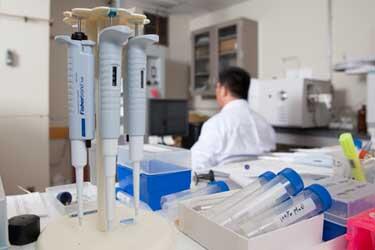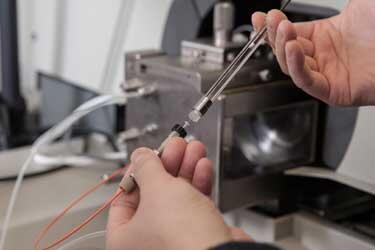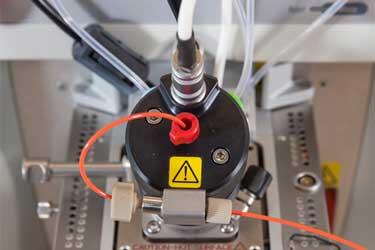Booking Information
The Queen’s Mass Spectrometry Facility currently consists of four mass spectrometers.
- Thermo Scientific Orbitrap Velos Pro (Easy-nLC/HESI Hybrid Ion Trap-Orbitrap Mass Spectrometer)
- Agilent AdvanceBio 6545XT LC/QTOF (1260 Infinity II LC APCI/ESI Quadrupole Time of Flight Mass Spectrometer)
- Bruker AutoFlex Speed (MALDI Time of Flight Mass Spectrometer)
- Thermo GC ISQ 7000 (low resolution GCMS Mass Spectrometer)
- Thermo LC ISQ EM (low resolution LCMS Mass Spectrometer)



This facility provides MS services and expertise for the analysis of small and macromolecules, proteins and enzymes to both users in the Queen’s community and from other institutions and industry. The current users of this facility include Queen’s researchers from Biology, Biochemistry, Cell Biology, Chemistry, Chemical Engineering, Geological Sciences, Immunology, Pharmacology, Microbiology, Pathology and Molecular Medicine, and a large number of researchers from various industries and other universities.
- Thermo Scientific Orbitrap Velos Pro (Easy-nLC/HESI Hybrid Ion Trap-Orbitrap Mass Spectrometer)
- Agilent AdvanceBio 6545XT LC/QTOF (1260 Infinity II LC APCI/ESI Quadrupole Time of Flight Mass Spectrometer)
- Bruker AutoFlex Speed (MALDI Time of Flight Mass Spectrometer)
- Thermo GC ISQ 7000 (low resolution GCMS Mass Spectrometer)
- Thermo LC ISQ EM (low resolution LCMS Mass Spectrometer)
Organic Analysis Mass Spectrometers:
Thermo Scientific Orbitrap Velos Pro, Qstar XL, GC-TOF and ZQ-MS. EI-GC-TOF Sample introduction on the GC TOF instrument occurs using a probe. The TOF analyzer enables high resolution (5000-7000) mass measurements with an accuracy of ~5 ppm. EI is most suitable for low molecular weight, low polarity compounds (m/z range ~1500).
ESI-Orbitrap Velos Pro:
The Fourier transform (FT) analyzer enables high resolution (up to 100000) mass measurement with an accuracy of less than 3 ppm. The HRMS for the analysis of mixtures can be obtained with combination of nLC and Orbitrap. The excellent mass accuracy (< 3 ppm with external calibration and < 1 ppm using internal calibration) allows us to give possible molecular formula.
Liquid chromatography mass spectrometry (LCMS)
The nLC-Orbitrap Velos Pro Supports qualitative and quantitative applications with low limits of detection.
| Type of Analysis | Description | Academic Price (Internal) | Academic Price (External) |
Commercial Price (Industry) |
|---|---|---|---|---|
| Mass Determination | Organic Compounds | |||
| Low resolution | $12/sample | $30/sample | $50/sample | |
| EI, high resolution | $15/sample | $50/sample | $70/sample | |
| ESI, high resolution | $30/sample | $50/sample | $70/sample | |
| Polymers, Peptides, Proteins | ||||
| Low resolution (MALDI) | $18/sample | $20/sample | $50/sample | |
| High resolution (NanoESI) | $30/sample | $50/sample | $70/sample | |
| MS/MS Measurements | QqTOF instrument | $18/sample |
$25/peptide up to maximum $150/sample |
$35/peptide up to maximum $240/sample |
| LC-MS Analysis | Single quadrupole instrument | $40/sample | $60/sample | $95/sample |
| LC-MS/MS Analysis | High resolution QqTOF instrument with 1h LC gradient run | $60/sample | $100/sample | $140/sample |
| Protein Sequence Identification | Peptide mapping | $30/sample | $60/sample | $90/sample |
| Manual MALDI MS/MS | $60/sample | $100/sample | $180/sample | |
| De novo Sequencing | MALDI and/or ESI MS/MS |
$50/peptide up to maximum $150/sample |
$60/peptide up to maximum $180/sample |
$95/peptide up to maximum $350/sample |
| Protein Post-translational Modifications | NanoLC MS/MS, 1.5h LC run (glycosylation, phosphorylation) | $100/sample | $200/sample | $350/sample |
| Protein Quantitation | NanoLC MS/MS, 1.5h LC run cICAT or iTRAQ | $100/sample | $150/sample | $240/sample |
| Sample Pretreatment | In-solution enzymatic digestion | $10/sample | $20/sample | $25/sample |
| C18 Ziptip desalting | $10/sample | $20/sample | $25/sample | |
| Dialysis and concentration | $20/sample | $50/sample | $70/sample | |
| In-gel tryptic digestion | $30/sample | $60/sample | $85/sample | |
Service Fees for Orbitrap Velos Pro Analysis (Bio-sample)
| Analysis | Description | PI's Users | Academic (Internal) | Academic (External) | University Affiliated | Industrial |
|---|---|---|---|---|---|---|
| ESI MS | HEMS, Formula, PMM | $30/h | $60/h | $90/h | $100/h | $150/h |
| ESI MSn | Structure information | $30/h | $80/h | $120/h | $130/h | $190/h |
| Nano LC MS | HPLC-HRMS | $40/h | $80/h | $120/h | $130/h | $190/h |
| Nano LC MSn | Protein ID in data dependent run | $50/h | $100/h | $150/h | $170/h | $240/h |
| Post translational modifications | FT-IT in data dependent run | $50/h | $150/h | $200/h | $230/h | $360/h |
| De Novo Sequencing | FT-FT | $50/h | $150/h | $200/h | $230/h | $360/h |
| Database Search | Proteome Discoverer | Free | $10/sample | $20/sample | $20/sample | $25/sample |
| Sample Pretreatment | In-solution digestion | n/a | $10/sample | $20/sample | $20/sample | $25/sample |
| In-gel digestion | n/a | $20/sample | $30/sample | $30/sample | $35/sample | |
| Ziptip | n/a | $10/sample | $20/sample | $20/sample | $25/sample |
1. 50% discount will be offered to PI users.
2. If Independent User(s) need a significant amount of help, $20 per hour will be charged.
3. The lower rate is offered to PI users for only 5 years.
4. A 20% discount will be offered to other users starting from the 3rd hour run for one registered time.
Mass Range Consideration
- Electron impact (EI) MS: 50-800 Da
- Low resolution ESI MS: 50- 2000 Da
- High resolution ESI MS: 50-70,000 Da
- High resolution MALDI MS: 600-40,000 Da
- High resolution MS/MS: 100-6000 Da
Selecting an Ionization Method
- EI: Stable, volatile samples (under high vacuum, up to heat at 350 degrees)
- ESI: Complex (such as organometallic compounds), non-volatile, thermally labile or unstable samples
- MALDI: organic polymers and biomolecules
MS samples are normally analyzed in the positive ionization mode because of high sensitivity, except some analysis of organic acids, sugars, nucleic acids have to be performed in negative ionization mode.
Solubility of Organic Compounds
Although EI MS samples can be submitted in either solid or liquid form, ESI MS analysis needs a soluble sample to be tested prior to submission. The best solvents used in MS analysis are recommended to be methanol, water, acetonitrile, or their combination, and samples dissolved in THF, methane chloride, DMSO are also acceptable.
Protein Samples
Proteins should be desalted with a dialysis in 10 mM ammonium bicarbonate solution or centrifugal filter in an appropriate MW cut-ff membrane tube. Coomassie stained gel bands of proteins from SDS-PAGE gels are submitted in centrifugal tubes without water, and labeling of sample names must be clearly present.
Please note the facility will not accept Bio-hazardous or Radio active labeled samples.
Mass spectrometry technology has expanded dramatically. Many students (including graduates and undergraduate) have shown great interest in newly developed MS technologies and the continuing growth applications in the biotechnology and pharmaceutical industries. The MS facility offers training to the students at Queen’s University.
Group Laboratory Demo
Mass spectrometry facility offers an exciting opportunity for a group of students at Queen’s University to understand the fundamental aspects of mass spectrometry and proteomics applications.
- Basic knowledge of MS instrumentation including EI, ESI, and MALDI ionization techniques and LC MS/MS analysis
- Experimental demonstration
- MS spectrum data interpretation
Individual Instrumentation Training
On-site training courses for analyzing small molecules / large biomolecules.
- Mass spectrometric instrumentation and technical development
- Sample preparation for MS analysis
- MALDI TOF, Nanospray ESI and LC MS/MS
- Database searching and manual data interpretation
The MS facility continues its ongoing efforts to support some critical research projects and highlights these application areas of MS strength. A collaborative network for analyzing biomolecules with many research scientists has been established. The joint team effort between the MS facility members and the following researcher groups has been creating new collaborative opportunities for a large number of research projects. The MS facility provides its unique expertise, instrumentation and technical strategies in helping the research groups to establish excellent co-operation programs especially in the cutting-edge research area of protein chemistry, chemical biology, structural biology and proteomics.
Participating Scientists and Research Groups
- Dr. Thomas E. Massey (Department of Pharmacology and Toxicology, Queen’s University)
- Dr. Tassds Anastassiades (Department of Biochemistry, Queen’s University)
- Dr. Bruce Elliott (Cancer Research Institute, Queen’s University)
- Dr. Susan Cole (Department of Pharmacology & Toxicology, Queen’s University)
- Dr. Gang Wu (Department of Chemistry, Queen’s University)
- Dr. William C. Plaxton (Department. of Biology, Queen’s University)
- Dr. Ceredwyn E Hill (Department of Medicine & Physiology, Queen’s University)
- Dr. Victor Tron (Department of Pathology and Molecular Medicine, Queen’s University)
- Dr. Kendall C. Swanson (Department of Animal and Poultry Science, University of Guelph)
- Dr. Richard W. Smith (Department of Biology, McMaster University)
- Dr. Colin B. Seymour (Department of Medical Physics and Applied Radiation Sciences, McMaster University)
- Dr. Lumsden JS (Department of Pathobiology, University of Guelph)
- Dr. Zongchao Jia (Department of Biochemistry, Queen’s University)
- Dr. Xiaolong Yang (Department of Pathology and Molecular Medicine, Queen’s University)
- Dr. Harry Schachter (Molecular Structure & Function, Hospital for Sick Children)
- Dr. Aled Edwards (Structural Genomics Consortium, University of Toronto)
- Dr. Sirano Dhe-Paganon (Structural Genomics Consortium, University of Toronto)
- Dr. Alexander F. Yakunin (Structural Proteomics in Toronto, University of Toronto)
- Dr. Kenneth G. Standing (Department of Physics, University of Manitoba)
- Dr. Frank Burczynski (Department of Pharmacy, University of Manitoba)
- Dr. Andrew M Kropinski (Laboratory for Foodborne Zoonoses, Public Health Agency of Canada)
Publications from the MS Facility Members (2007-2008)
- Lee DC, Zheng J, She YM, Jia Z. Structure of Escherichia Coli tyrosine kinase EtK reveals novel activation mechanism. EMBO J. 2008, 27(12), 1758-1766.
- Uhrig RG, She YM, Leach CA, Plaxton WW. Regulatory monoubiquitination of phosphoenolpyruvate carboxylase in germinating castor oil seeds. J. Biol. Chem. 2008, 283(44):29650-29657.
- Uhrig RG, O’leary B, Spang HE, MacDonald JA, She YM, Plaxton WC. Co-immunopurification of phosphorylated bacterial- and plant-type phosphoenol-pyruvate carboxylases with the plastidial pyruvate dehydrogenase complex from developing castor oil seeds. Plant Physiol, 2008, 146 (3) 1346-1357.
- Lingohr EJ, Vilegas A, She YM, Ceyssens PJ, Kropinski AM. The genome and proteome of the Kluyvera bacteriophage Kvp1 – another member of the T7-like Autographivirinae. Virol. J. 2008, 5:122.
- Mendez II, Weiner SG. She YM, Yeager M, Coombs KM. Conformation changes accompany activation of reovirus RNA-dependent RNA polymerase. Journal of Structural Biology. 2008, 162(2), 277-289.
- Kwan ICM, Wong A, She YM, Smith ME, Wu G. Direct NMR evidence for Ca2+ ion binding to G-quartets. Chem Commun, 2008, 6, 682-684
- Keller BO, Sui J, Young AB, Whittal RM. Interferences and contaminants encountered in modern mass spectrometry. Anal. Chim. Acta 2008, 627, 71-81
- Wang PYT, Boccanfuso M, Lemay AM, Devries H, Sui J, She YM. Hill CE. Sex-specific extraction of organic anions by the rat liver. Life Sci. 2008, 82(7-8), 436-443.
- She YM, Krokhin O, Spicer V, Loboda A, Garland G, Ens W, Standing KG. Formation of (bn-1 + H2O) ions by collisional activation of MALDI-formed peptide [M+H]+ ions in a QqTOF mass spectrometer. J. Am. Soc. Mass Spectrom. 2007, 18(6), 1024-1037.
- Smith CA, Lau KM, Rahmani Z, Dho SE, Brothers G, She YM, Berry DM, Bonneil E, Thibault P, Schweisguth F, Le Borgne R, McGlade CJ. aPKC-mediated phosphorylation regulates asymmetric membrane localization of the cell fate determinant Numb. EMBO J. 2007, 26(2), 468-480.
- Narindrasorasak S, Kulkarni P, Deschamps P, She YM, Sarkar B. Characterization and copper binding properties of human COMMD1 (MURR 1). Biochemistry, 2007, 46(11), 3116-3128.
- Kwan ICM, She YM, Wu G. Trivalent lanthanide metal ions promote formation of stacking G-quartets. Chemical Communications, 2007, 41, 4286-4288.
- Weerasekera R, She YM, Markham K, Bai Y, Opalka N, Orlicky S. Sicheri F. Kislinger T, Schmitt-Ulms G. Interactome and interface protocol (2IP): a novel strategy for high sensitivity topology mapping of protein complexes. Proteomics, 2007, 7(21), 3835-3852.
- Crandall IE, Szarek WA, Vlahakis JZ, Xu Y, Vohra R, Sui J, Kisilevsky R. Sulfated cyclodextrins inhibit the entry of plasmodium into red blood cells: implications for malarial therapy. Biochem Pharmacology, 2007, 73(5): 632-642.
| Address
Department of Chemistry |
Phone
Office: 613-533-6539 |
Hours
Monday to Friday |
Contact Information

Dr. Mario Khalil
Email: mass.spec@queensu.ca